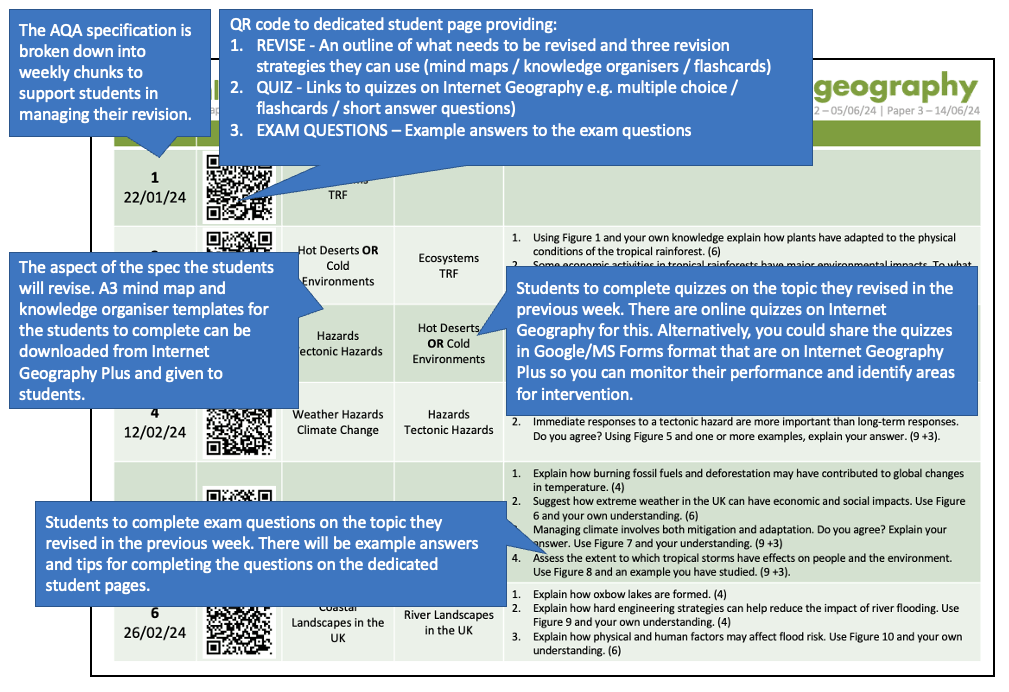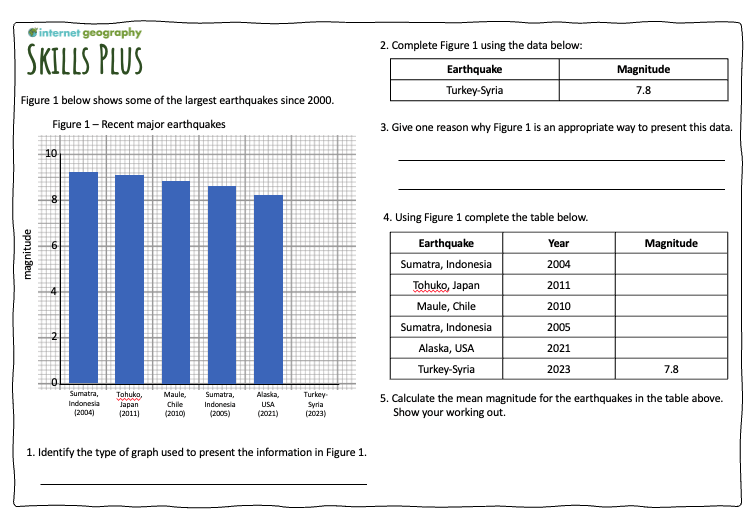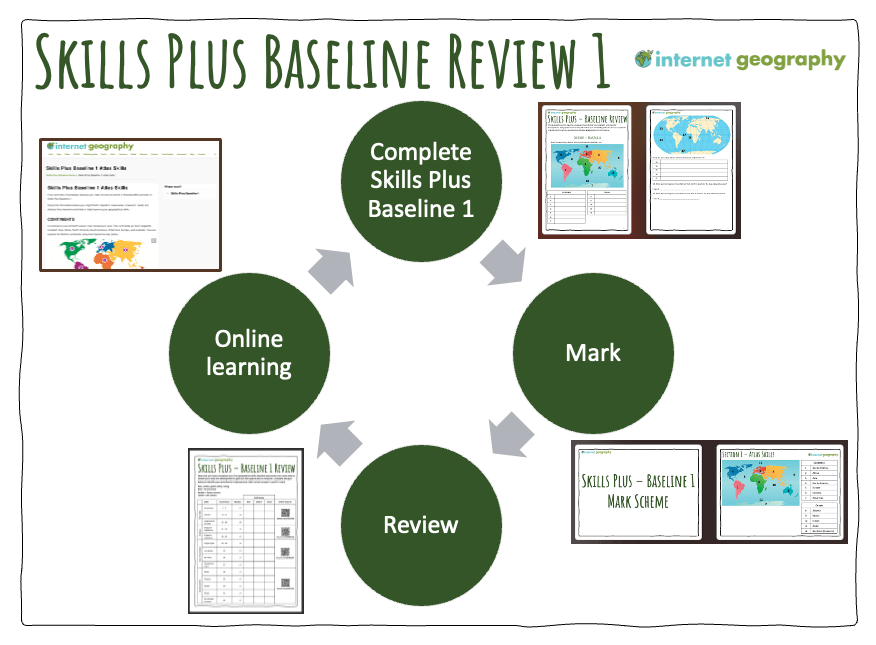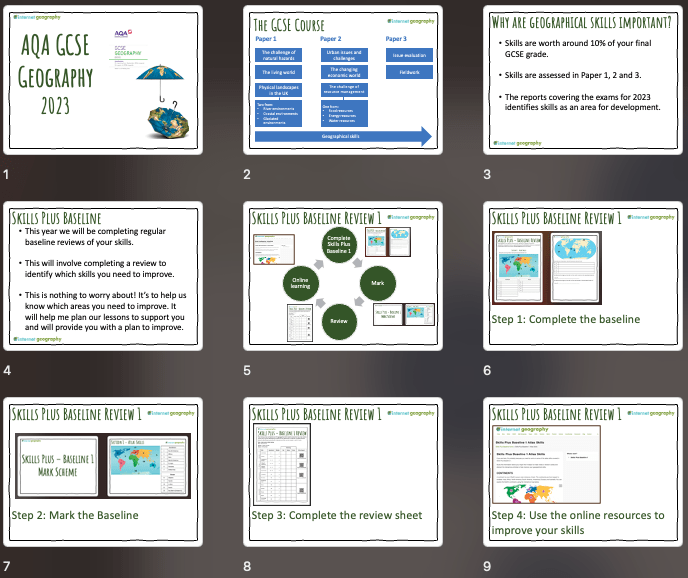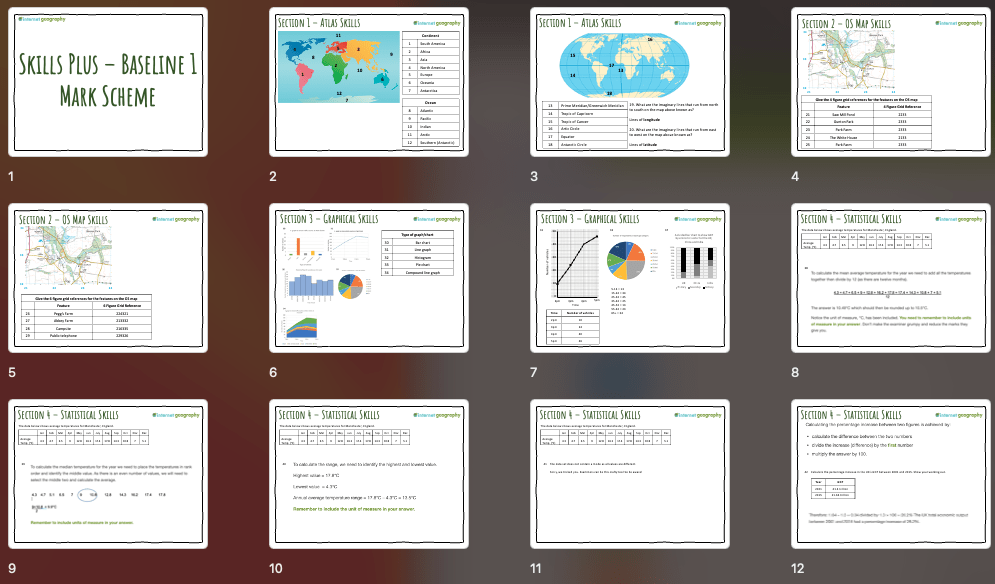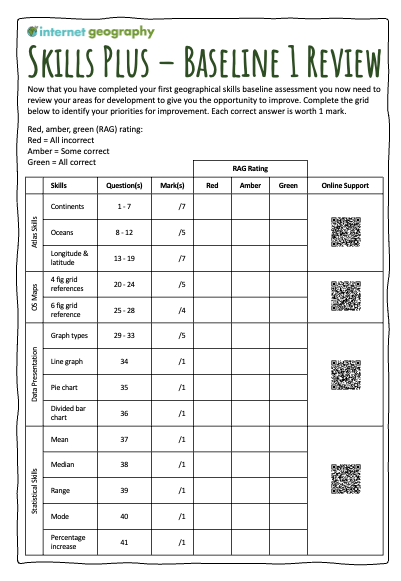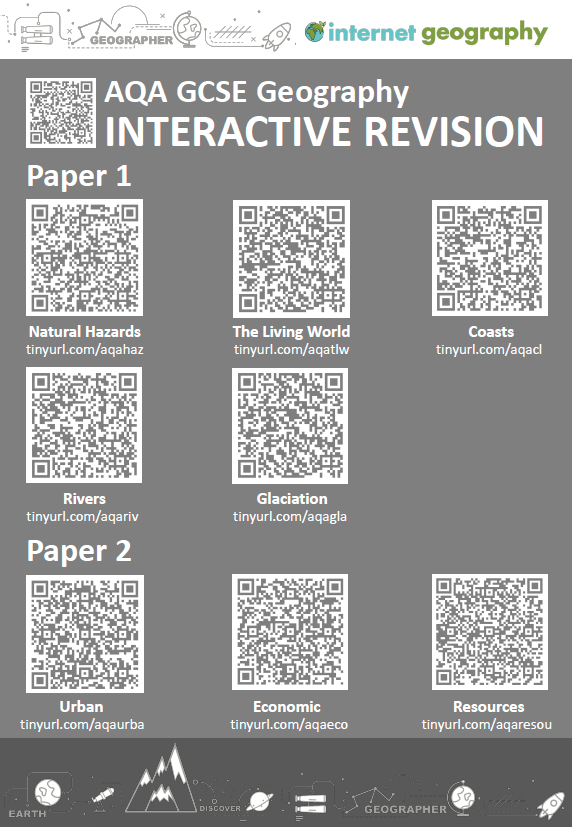Revision Resources on Internet Geography Plus
Revision Resources on Internet Geography Plus
As we head into revision season, we wanted to share a selection of our resources to support you and your students in preparing for the 2024 AQA GCSE exams.
There’s a huge range of revision resources on Internet Geography Plus, so we’ve pulled together a collection of some of our favourites to help give you an overview of the resources on Plus that will save you time and help your students prepare for their exams.
If you have any specific requests, let us know!
Subject Knowledge
The Final Countdown
The Final Countdown is a comprehensive weekly approach to revision that involves students revisiting content, checking knowledge and understanding through quizzes, and allowing students to attempt a range of exam questions with model answers. We’ve made a few updates this year, and you can download the student and teacher resources from here: https://www.internetgeography.net/internet-geography-plus/the-final-countdown/
Revision Boost Booklets
Our Revision Boost Booklets are an ideal way to support students revisiting content. Each booklet contains QR codes to pages on InternetGeography to support students in covering the content for Papers 1 and 2.
Log in and head over to https://www.internetgeography.net/internet-geography-plus/revision-boost-booklets/ to download!
Revision Quizzes
We have an extensive collection of multiple-choice quizzes available in the booklet and Google/MS Forms format. The Google/MS Forms can be copied to your drive in one click and are self-marking to save you time!
Google/MS Forms Quizzes: https://www.internetgeography.net/internet-geography-plus/geography-online-quiz-forms/
Multiple-choice booklets: https://www.internetgeography.net/internet-geography-plus/multiple-choice-knowledge-checker/
Revision Mats
Retrieval questions with model answers: https://www.internetgeography.net/geography-revision-mats/
Find and Fix
A great way to check subject knowledge, Find and Fix involves students finding errors and then fixing them. Download from here: https://www.internetgeography.net/internet-geography-plus/find-and-fix/
Geogrevise
Booklets containing retrieval questions, with example answers provided: https://www.internetgeography.net/subscribe/geogrevise/
Knowledge Organisers
A comprehensive collection of knowledge organisers covering content from across the specification: https://www.internetgeography.net/internet-geography-plus/geography-knowledge-organisers/
Odd One Out
Students identify the odd one out: https://www.internetgeography.net/internet-geography-plus/odd-one-out/
Infographics
A huge collection of infographics summarising a range of areas of the specification and case studies: https://www.internetgeography.net/internet-geography-plus/infographics/
Recap Sheets
There are 88 recap sheets containing retrieval activities to revisit areas of the specification: https://www.internetgeography.net/internet-geography-plus/recap/
Case Study Summaries
Summary sheet to support students structuring revision notes:https://www.internetgeography.net/internet-geography-plus/case-study-summaries/
Exam Technique
Mock exam papers and mark schemes
A collection of mock exam questions and full papers (inc. mark schemes) can be downloaded here: https://www.internetgeography.net/internet-geography-plus/aqa-gcse-geography-plus-resources/
Beyond the Resource
Resources to support students answering a question that involves a figure: https://www.internetgeography.net/internet-geography-plus/exam-skills-plus/
Rewrite it
Students review answers to exam questions, plan their answers, and then have a go at the question: https://www.internetgeography.net/internet-geography-plus/re-write-it/
PEEL templates for 6-9 mark questions
Templates covering a range of 6-9 mark questions across the specification: https://www.internetgeography.net/download/37859/?tmstv=1668616844
Apply your knowledge grids
Resources to support students in applying their knowledge to exam questions. These resources support students in going further than regurgitating facts and actually applying their knowledge to exam questions: https://www.internetgeography.net/internet-geography-plus/apply-your-knowledge-grids/
Geographical Skills
Which was the photographer facing? https://www.internetgeography.net/download/34021/?tmstv=1684232115
How to – statistical skills: https://www.internetgeography.net/download/33624/
How to – graphical skills: https://www.internetgeography.net/download/33739/
Geographical Skills multiple choice booklets: https://www.internetgeography.net/geographical-skills-multiple-choice-booklets/
Interpreting OS Maps booklets
Booklets to support students interpreting OS maps in the context of coastal and river landscapes: https://www.internetgeography.net/internet-geography-plus/interpreting-os-maps/
What is The Final Countdown?
The Final Countdown is a comprehensive set of resources to support students in the run-up to exams. The work of JB GeogTeacher inspired the initiative.
The Final Countdown has been created to provide students with weekly revision activities in the run-up to the AQA GCSE Geography exams in May and June 2023. Each set contains a six-week revision plan to support students in organising their revision. In addition, each week has a QR code to online resources, guides, quizzes and exam questions (including example answers and mark schemes) for students to use to prepare for their final exams.
The image below illustrates how The Final Coundown works.
Internet Geography Plus subscribers can access the six-weekly revision sheets now.
Each week, revision is divided into three sections: revise, quiz and exam questions.
Revise
Students revise an area of the specification, and the QR code will take them to a menu of pages on Internet Geography to support this. In addition, we’ve provided A3 templates for the students to use to structure their revision. These include knowledge organisers and mind maps. The image below shows examples.
Internet Geography Plus subscribers can download all knowledge organisers, and mind maps from The Final Countdown page on Internet Geography Plus.
Review
Review allows students to revisit their learning by completing online multiple-choice quizzes to test their knowledge. These are all available on Internet Geography for free. Alternatively, Plus subscribers could direct their students to the Internet Geography Plus MS/Google Forms quizzes to monitor progress (and completion!).
Exam Questions
Finally, students complete exam questions based on the area they revised the previous week. To support students, examples of answers to each question are published on each revision page. You can see a sample here.
Internet Geography Plus subscribers can access the resources here. However, if you’re not a subscriber, why not join to access this and over one thousand other resources? Please take a look at our subscription options.
If you have any questions, drop us an email.
Improve Geographical Skills with Skills Plus
Feedback from the recent AQA GCSE Geography examiner’s report suggests that geographical skills are an area for development. Given that geographical skills are worth 10% of the GCSE, across three papers, we’ve been thinking about how Internet Geography Plus can support you in improving students’ geographical skills. Considering so many skills are covered in the AQA GCSE specification, we felt a quick fix wouldn’t be enough. Therefore, this year, we are developing several sets of resources to support you, including:
- Skills Plus
- Skills Plus Baseline Assessments
What is Skills Plus?
Skills Plus is a collection of activities that focus on applying geographical skills in the context of the units covered by the specification. Each Skills Plus sheet focuses on one or two skills, and questions are based on a particular unit. They are short, focused activities that can be used as starter or plenary activities. They can also be issued to individual students if there is a particular area for development identified from assessments or intervention sessions etc. Each Skills Plus resource is editable and includes a mark scheme to reduce your workload.
Subscribers can access the first of these resources in the new Skills Plus area of Internet Geography Plus. We’ll be adding new Skills Plus resources regularly over the coming year. If you have a specific request, please get in touch. Not got access to Internet Geography Plus? Please purchase a low-cost annual subscription to access these and over a thousand other resources.
Skills Plus Baseline Assessments
As well as Skills Plus, we are developing a comprehensive, planned approach to developing geographical skills through our new Skills Plus Baseline Assessments. The approach involves:
- Students complete a baseline assessment covering various geographical skills.
- Students assess their performance (a mark scheme is provided, including a PowerPoint that can be used to take the students through the answers).
- Students complete a review sheet to RAG rate their performance across the different skills (a PowerPoint is also available for you to deliver this)
- Students use QR codes/web links to access resources on Internet Geography to support improving their identified areas for development.
- The assessment can be repeated later to review progress.
We’ll be adding a number of Skills Plus Baseline assessments to Internet Geography Plus over the coming year, which review the range of geographical skills identified in the specification (and a few relevant extras). As there are so many skills to cover, we have decided to divide the skills and produce a series of baseline assessments this academic year.
The first Skills Plus Baseline Assessment (see image below) is now available to Internet Geography Plus subscribers.
The first Skills Plus Assessment addresses relatively basic geographical skills students should know. However, we have included a couple of more challenging elements so that most students will have areas for development!
Each Skills Plus Baseline will cover a range of atlas, OS maps, graphical, and statistical skills.
An introduction PowerPoint is available to download to support you in launching the Skills Plus Baseline.
Once the students have completed the Skills Plus Assessment, they will self-assess using the provided mark scheme, which includes a PowerPoint presentation that you can use to take the students through the processes.
Students then review their performance using the Skills Plus Baseline Review (see below). There is a PowerPoint to guide students through this process on Internet Geography Plus.
The completed review sheet will help students identify their priorities for skills development. The review sheets include a QR code/link to free-to-access online resources on Internet Geography that students will use to improve their geographical skills. These pages are now available to access.
We’re working on a spreadsheet to identify which geographical skills are covered in this and future assessments. Hopefully, it will be a helpful tracking tool that provides a clear overview of the skills that have been/will be covered. It can also be shared with those delightful OFSTED people, if you are lucky enough to have a visit, to illustrate how you are taking a systematic approach to skills development.
Subscribers can now access the new Skills Plus Baseline and Baseline Review in the new Skills Plus area of Internet Geography Plus. Mark schemes and presentations will be added later today.
We’ll be adding further baseline assessments over the coming year. If you have a specific request, please get in touch. Not got access to Internet Geography Plus? Please purchase a low-cost annual subscription to access these and over a thousand other resources.
AQA GCSE Geography Interactive Revision Resources
Did you know? Students can access a growing collection of free interactive resources on Internet Geography to support revision and retrieval.
We’ve compiled a PDF file you can share with students containing QR codes and short URLs so they can get straight to the area they want to revise. Just click the image below to download.
The 2023 Turkey Syria Earthquake
We’re collating resources to support teachers covering the recent devastating earthquake in Turkey. First and foremost, we’ve shared links to anyone who can support NGOs working to help those affected. Additionally, there are links to support teachers in sensitively delivering events such as the earthquake, including advice on supporting the young people affected.
Earthquake Relief
There are many aid agencies providing support to those affected by the recent earthquake that has affected tens of thousands of people in Turkey and Syria, including:
- DEC Turkey Syria Earthquake Appeal
- Save the Children Turkey Syria Earthquake Appeal
- British Red Cross Earthquake Appeal
Please email us if you are aware of other aid agencies providing support or can provide a link for donations to aid agencies.
Support
Teachers
Below we have included links to websites that support teaching events such as this in a considered way. After all, many children from Turkey and Siria are being educated in schools outside of the country and may be in one of your classes.
Supporting young people during the initial response to a disaster
Media
Warning – Some of these videos contain footage you may find distressing.
Sky News – Devastation from Above – An aerial view of the Turkey-Syria earthquake
News Links
BBC
BBC News Turkey – Syria Earthquake Home
Turkey earthquake: Screaming, shaking… how it felt when the quake hit
Turkey earthquake: Where did it hit and why was it so deadly?
Turkey earthquake: Why did so many buildings collapse?
Turkey-Syria earthquake: Fire at Iskenderun port extinguished
Syria: Rescuers search for earthquake survivors in Harem
Turkey earthquake fault lines mapped from space – BBC News
Turkey-Syria earthquake: UK aid appeal raises more than £50m
Turkey quake: President Erdogan accepts some problems with response
Turkey earthquake rescue efforts disrupted by security concerns
Turkey earthquake: Roman-era castle destroyed by quake
Turkey earthquake: Hope as foreign help arrives in quake-ravaged Antakya
US pledges $85m for Turkey-Syria earthquake relief
The Economist (requires a free account)
What made the earthquake in Turkey and Syria so deadly?
The Guardian
The Guardian – Turkey – Syria Earthquake Home
Turkey and Syria earthquake devastation – in pictures
Tuesday briefing: Why the Turkey and Syria earthquake was a catastrophe
Before and after satellite images show scale of earthquake destruction in Turkey
Turkey earthquake death toll prompts questions over building standards
Istanbul stock market shuts to prevent selloff after earthquake
Sky News
Sky News Turkey – Syria Earthquake Home
Turkey-Syria earthquake: Which countries have offered to help and what aid are they providing?
Podcasts
BBC Science in Action – Turkey-Syria Earthquake
Newly available Maxar satellite imagery shows several hundred meters long surface rupture with horizontal displacements up to 4m near Nurdağı, Gaziantep province, Turkey. pic.twitter.com/3JVZTTHrk1
— Nahel Belgherze (@WxNB_) February 9, 2023
The M7.8 earthquake in Türkiye occurred on a strike-slip fault. During this type of faulting event one side of the fault slides horizontally past the other. Things that cross the fault like fences, roads or train tracks are good markers for showing the way the fault moved. https://t.co/uAxHsDnf59 pic.twitter.com/XreVABZnl1
— Wendy Bohon, PhD 🌏 (@DrWendyRocks) February 8, 2023
Why did the earthquakes in Turkey happen? pic.twitter.com/eA91LNZpM0
— Wendy Bohon, PhD 🌏 (@DrWendyRocks) February 7, 2023
An unfolding thread helping us understand the nature of the devastating earthquake affecting Turkey and Syria.
— Alistair Hamill MCCT (@lcgeography) February 6, 2023
Internet Geography Primary Plus
We’re excited to announce that we’ll soon be launching Internet Geography Primary Plus. As you might have guessed, we’re extending our Plus family to include resources specifically developed for the primary school curriculum. Our team of writers are currently developing editable resources for use in your classroom!
We want to make sure Internet Geography Primary Plus works for you! So, we’d love to hear your views about the types of resources you’d like to see made available on Internet Geography Primary Plus. As a thank you for taking the time to share your views, we’ll make sure you’re the first to know about the launch of Internet Geography Primary Plus and will throw in a discount on your first annual subscription!


